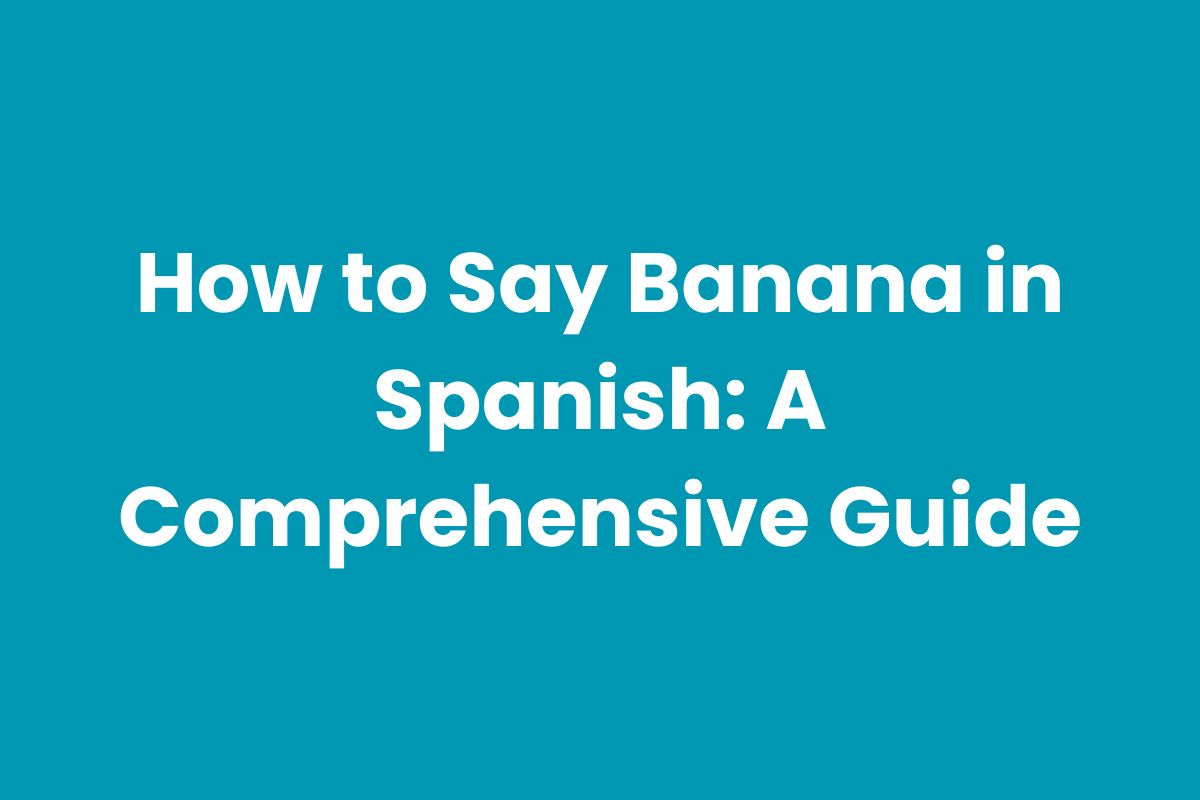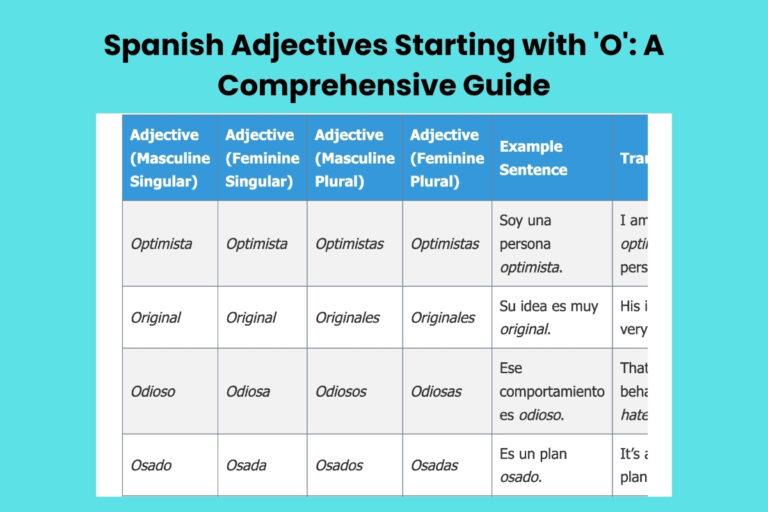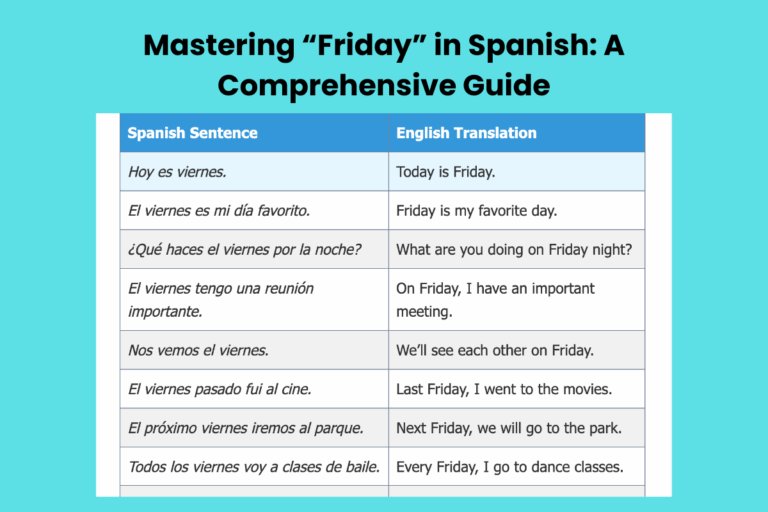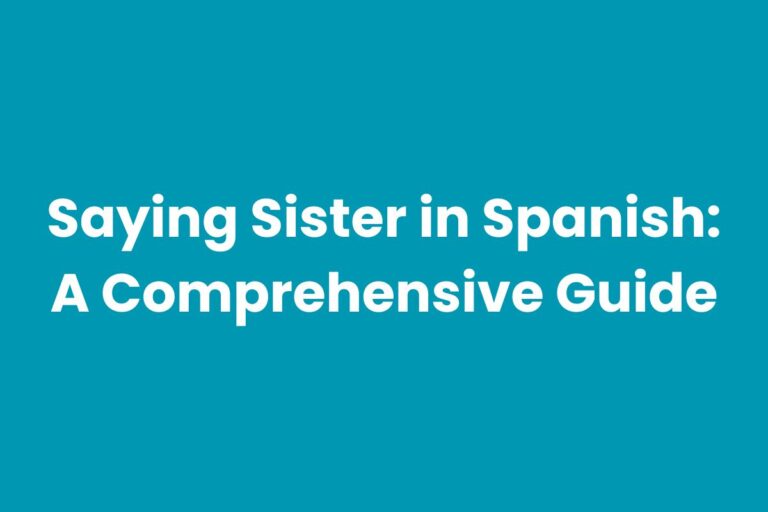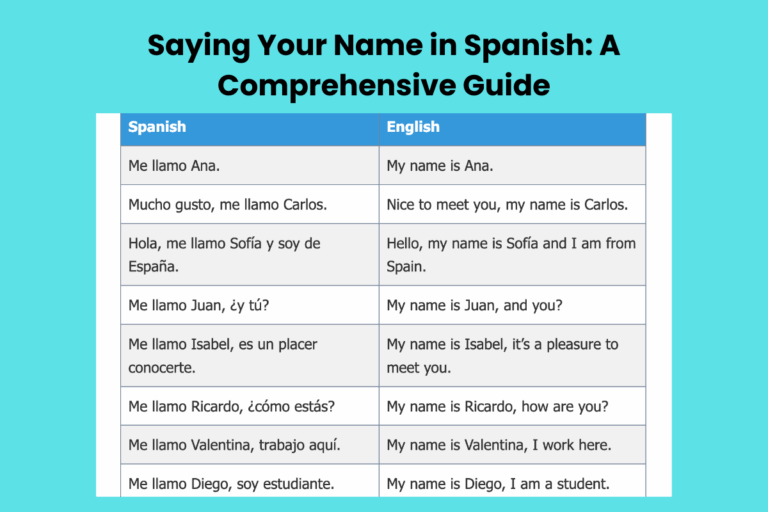How to Say Banana in Spanish: A Comprehensive Guide
Learning how to say common words in different languages is a fundamental step in language acquisition. Knowing how to say “banana” in Spanish is not just about vocabulary; it’s a gateway to understanding regional variations, gendered nouns, and the nuances of everyday conversation.
This article provides a comprehensive guide to understanding the various ways to say “banana” in Spanish, exploring their usage, regional differences, and grammatical contexts. Whether you’re a beginner or an advanced learner, this guide will equip you with the knowledge and confidence to use this simple word effectively in Spanish-speaking environments.
From basic definitions to advanced usage, this article covers everything you need to know about “banana” in Spanish.
Table of Contents
- Introduction
- Definition of “Banana” in Spanish
- Structural Breakdown
- Types and Categories of “Banana”
- Examples of Usage
- Usage Rules
- Common Mistakes
- Practice Exercises
- Advanced Topics
- FAQ
- Conclusion
Definition of “Banana” in Spanish
The most common way to say “banana” in Spanish is “plátano.” However, the term used can vary significantly depending on the region. In some countries, like Argentina, Uruguay, and parts of Spain, the word “banana” itself is commonly used. This regional variation is crucial to understand to avoid confusion and communicate effectively. The word “banana”, although borrowed from English, has been incorporated into the vocabulary of some Spanish-speaking countries.
In addition to “plátano” and “banana,” another term you might encounter is “guineo,” which is prevalent in the Caribbean and parts of Central America. Understanding these regional differences is vital for clear communication. Each term carries the same basic meaning but is favored in specific geographic areas.
The grammatical gender of these words is also important. “Plátano” is a masculine noun, so it takes masculine articles like “el” (the) or “un” (a).
For example, “el plátano” (the banana) or “un plátano” (a banana). Similarly, “guineo” is also masculine.
While “banana” is often used as a masculine noun, its usage can sometimes be flexible depending on the region.
Structural Breakdown
The word “plátano” consists of three syllables: plá-ta-no. The stress falls on the first syllable, “plá.” This pronunciation is consistent across most Spanish-speaking regions that use this term. It follows the typical Spanish phonetic rules, making it relatively easy for English speakers to pronounce once they understand the stress pattern.
The word “banana” is pronounced similarly to its English counterpart but with a slight Spanish accent. The stress usually falls on the second syllable: ba-ná-na. This word is often used as is, especially in regions where English influence is stronger or where it has been adopted as a standard term.
The word “guineo” is pronounced with two syllables: gui-ne-o. The stress falls on the second syllable, “ne.” This term is commonly used in Caribbean countries like Puerto Rico, the Dominican Republic, and Cuba, as well as parts of Central America. Its pronunciation is straightforward and follows standard Spanish phonetic rules.
Types and Categories of “Banana”
Based on Ripeness
In Spanish, describing the ripeness of a banana can be done in various ways. Here are some common terms:
- Verde: Green (unripe)
- Pintón: Spotted (partially ripe)
- Maduro: Ripe
- Pasado: Overripe
Based on Variety
Different varieties of bananas also have specific names in Spanish:
- Plátano macho: Plantain (cooking banana)
- Plátano enano: Cavendish banana (common eating banana)
- Guineo manzano: Apple banana
Regional Variations
As mentioned earlier, the term used for “banana” itself varies by region:
- Plátano: Most of Latin America, Spain
- Banana: Argentina, Uruguay, parts of Spain
- Guineo: Caribbean, parts of Central America
Examples of Usage
Here are some examples of how to use the word “banana” (and its variants) in different contexts. These examples are organized by the term used (“plátano,” “banana,” and “guineo”) and the situation (describing, buying, cooking, etc.).
Examples Using “Plátano”
The following table provides examples of how to use the word “plátano” in various sentences. Each example includes the Spanish sentence and its English translation.
| Spanish Sentence | English Translation |
|---|---|
| Quiero un plátano para el desayuno. | I want a banana for breakfast. |
| El plátano está muy maduro. | The banana is very ripe. |
| ¿Cuánto cuesta un kilo de plátanos? | How much does a kilo of bananas cost? |
| Este plátano es de Canarias. | This banana is from the Canary Islands. |
| Me gusta comer plátanos con miel. | I like to eat bananas with honey. |
| El plátano verde no sabe bien. | A green banana doesn’t taste good. |
| Compré plátanos en el mercado. | I bought bananas at the market. |
| ¿Quieres un plátano frito? | Do you want a fried banana? |
| El plátano es una fruta muy nutritiva. | The banana is a very nutritious fruit. |
| Voy a plantar un árbol de plátano. | I’m going to plant a banana tree. |
| El plátano es mi fruta favorita. | The banana is my favorite fruit. |
| Necesito plátanos para hacer un batido. | I need bananas to make a smoothie. |
| El plátano tiene muchas vitaminas. | The banana has many vitamins. |
| ¿Has probado el plátano macho? | Have you tried plantain? |
| El plátano es perfecto para un snack rápido. | The banana is perfect for a quick snack. |
| El mono comió el plátano rápidamente. | The monkey ate the banana quickly. |
| Prefiero los plátanos orgánicos. | I prefer organic bananas. |
| El plátano se está poniendo negro. | The banana is turning black. |
| Añadí plátano a mi avena. | I added banana to my oatmeal. |
| El plátano es bueno para la salud. | The banana is good for your health. |
| El plátano es más dulce que la manzana. | The banana is sweeter than the apple. |
| En mi país, comemos plátano todos los días. | In my country, we eat banana every day. |
| El plátano es fácil de pelar. | The banana is easy to peel. |
Examples Using “Banana”
The following table provides examples of how to use the word “banana” in various sentences. These examples are more common in regions like Argentina, Uruguay, and parts of Spain.
| Spanish Sentence | English Translation |
|---|---|
| Quiero una banana para después del gimnasio. | I want a banana for after the gym. |
| La banana está un poco verde. | The banana is a little green. |
| Compré bananas en la verdulería. | I bought bananas at the greengrocer’s. |
| ¿Te gusta la torta de banana? | Do you like banana cake? |
| Voy a agregar banana a mi licuado. | I’m going to add banana to my smoothie. |
| La banana es una buena fuente de potasio. | The banana is a good source of potassium. |
| Necesito bananas para hacer pan de banana. | I need bananas to make banana bread. |
| ¿Cuántas bananas quieres? | How many bananas do you want? |
| La banana es perfecta para llevar de viaje. | The banana is perfect for taking on a trip. |
| La banana me da energía. | The banana gives me energy. |
| La banana es ideal para los niños. | The banana is ideal for children. |
| La banana se puede congelar. | The banana can be frozen. |
| Me encanta el helado de banana. | I love banana ice cream. |
| La banana es muy versátil. | The banana is very versatile. |
| ¿Has probado la banana con dulce de leche? | Have you tried banana with dulce de leche? |
| La banana es mi snack favorito. | The banana is my favorite snack. |
| Compré una banana orgánica. | I bought an organic banana. |
| La banana es fácil de digerir. | The banana is easy to digest. |
| La banana es rica en fibra. | The banana is rich in fiber. |
| La banana es buena para el corazón. | The banana is good for the heart. |
| La banana es excelente para los deportistas. | The banana is excellent for athletes. |
| La banana es un postre saludable. | The banana is a healthy dessert. |
| La banana es un alimento económico. | The banana is an economical food. |
Examples Using “Guineo”
The following table provides examples of how to use the word “guineo” in sentences. These examples are most common in the Caribbean and parts of Central America.
| Spanish Sentence | English Translation |
|---|---|
| Quiero un guineo verde para hacer tostones. | I want a green banana to make tostones. |
| El guineo maduro es muy dulce. | The ripe banana is very sweet. |
| En mi país, comemos guineos con bacalao. | In my country, we eat bananas with codfish. |
| ¿Cuánto cuestan los guineos en el mercado? | How much do the bananas cost at the market? |
| Voy a freír unos guineos para la cena. | I’m going to fry some bananas for dinner. |
| El guineo es una fruta tropical. | The banana is a tropical fruit. |
| Necesito guineos para hacer un sancocho. | I need bananas to make a sancocho. |
| ¿Te gusta el mofongo de guineo? | Do you like banana mofongo? |
| El guineo es muy popular aquí. | The banana is very popular here. |
| El guineo es una fuente de energía. | The banana is a source of energy. |
| Este guineo es muy grande. | This banana is very big. |
| El guineo está lleno de nutrientes. | The banana is full of nutrients. |
| Me gusta el guineo con mantequilla de maní. | I like banana with peanut butter. |
| El guineo es perfecto para un desayuno rápido. | The banana is perfect for a quick breakfast. |
| El guineo es un ingrediente común en los postres. | The banana is a common ingredient in desserts. |
| El guineo es una buena opción para los bebés. | The banana is a good option for babies. |
| Compré guineos en la tienda de la esquina. | I bought bananas at the corner store. |
| El guineo es fácil de transportar. | The banana is easy to transport. |
| El guineo es un alimento básico en mi dieta. | The banana is a staple in my diet. |
| El guineo es delicioso en batidos. | The banana is delicious in smoothies. |
| El guineo es un regalo de la naturaleza. | The banana is a gift from nature. |
| El guineo es una fruta imprescindible. | The banana is an essential fruit. |
| El guineo es un símbolo de mi cultura. | The banana is a symbol of my culture. |
Usage Rules
When using “plátano,” “banana,” or “guineo,” remember the following:
- Gender Agreement: All three words are generally masculine. Use “el” or “un” before them.
- Regional Awareness: Choose the word appropriate for the region you are in or the region you are referring to.
- Context: Consider the context. While “plátano” is generally understood, using “banana” in certain regions might sound foreign.
Pluralization: The plural form of “plátano” is “plátanos,” of “banana” is “bananas,” and of “guineo” is “guineos.” For example, “Quiero comprar tres plátanos” (I want to buy three bananas).
Descriptive Adjectives: When using adjectives to describe the banana, ensure they agree in gender and number. For example: “El plátano maduro” (The ripe banana), “Las bananas verdes” (The green bananas).
Common Mistakes
One common mistake is using the wrong term for “banana” in a specific region. For example, using “banana” in a country where “plátano” is the standard term might cause confusion.
Another common mistake is incorrect gender agreement. For example, saying “la plátano” instead of “el plátano.”
Here’s a table illustrating some common mistakes and their corrections:
| Incorrect | Correct | Explanation |
|---|---|---|
| La plátano | El plátano | “Plátano” is a masculine noun. |
| Quiero una plátano | Quiero un plátano | Masculine article required. |
| Compré bananas en Ecuador (where “plátano” is common) | Compré plátanos en Ecuador | Using the regional term is more appropriate. |
| Los banana son amarillos | Las bananas son amarillas (in regions where “banana” is used) or Los plátanos son amarillos | Adjective and article agreement. |
Practice Exercises
Test your knowledge with these practice exercises. Fill in the blanks with the correct word (“plátano,” “banana,” or “guineo”) and the appropriate article (“el,” “la,” “un,” “una”).
Exercise 1: Fill in the Blanks
- Quiero ______ _______ para el desayuno. (banana)
- ¿Cuánto cuesta ______ kilo de ________? (plátano)
- En mi país, comemos _______ con bacalao. (guineo)
- _______ está muy maduro. (plátano)
- Compré _______ en la tienda. (banana)
- Necesito _______ para hacer tostones. (guineo)
- ¿Quieres ________ frito? (plátano)
- _______ es una fruta tropical. (banana)
- Me gusta comer _______ con miel. (plátano)
- Voy a plantar _______ árbol de ________. (banana)
Answers:
- una banana
- el, plátanos
- guineos
- El plátano
- bananas
- guineos
- plátano
- La banana
- plátanos
- un, banana
Exercise 2: Translation
Translate the following sentences into Spanish, using the appropriate term for “banana” based on the context.
- I want to buy a banana.
- The bananas are very ripe.
- Do you like fried plantains?
- Bananas are a good source of potassium.
- We eat bananas with codfish in my country.
- I need bananas for my smoothie.
- This banana is from the Canary Islands.
- How much does a kilo of bananas cost?
- I like to eat bananas with honey.
- Bananas are my favorite fruit.
Answers (using “plátano” as the default):
- Quiero comprar un plátano.
- Los plátanos están muy maduros.
- ¿Te gustan los plátanos fritos? (or Plátanos machos fritos)
- Los plátanos son una buena fuente de potasio.
- En mi país, comemos guineos con bacalao. (If referring to a Caribbean country)
- Necesito plátanos para mi batido.
- Este plátano es de Canarias.
- ¿Cuánto cuesta un kilo de plátanos?
- Me gusta comer plátanos con miel.
- Los plátanos son mi fruta favorita.
Exercise 3: Regional Usage
Choose the most appropriate term for “banana” based on the region provided.
- Argentina: ________
- Ecuador: ________
- Puerto Rico: ________
- Spain: ________
- Uruguay: ________
- Dominican Republic: ________
- Mexico: ________
- Cuba: ________
- Colombia: ________
- Venezuela: ________
Answers:
- Argentina: Banana
- Ecuador: Plátano
- Puerto Rico: Guineo
- Spain: Plátano or Banana
- Uruguay: Banana
- Dominican Republic: Guineo
- Mexico: Plátano
- Cuba: Guineo
- Colombia: Plátano
- Venezuela: Plátano
Advanced Topics
For advanced learners, exploring idiomatic expressions and cultural contexts can enhance understanding. For example, the phrase “estar como un plátano” can mean “to be very happy” in some regions.
Another advanced topic is the use of diminutives and augmentatives. For example, “platanito” means “small banana,” while “platanote” means “large banana.” These forms add nuance to your vocabulary and demonstrate a deeper understanding of the language.
Finally, understanding the agricultural significance of bananas in different Spanish-speaking countries provides cultural context. For example, certain regions are known for specific varieties of bananas, and this knowledge can enrich your conversations.
FAQ
- Is “plátano” always the correct term for “banana” in Spanish?
No, while “plátano” is widely used, “banana” is common in Argentina, Uruguay, and parts of Spain, and “guineo” is prevalent in the Caribbean and Central America. - Are “plátano” and “plátano macho” the same thing?
No, “plátano” generally refers to the common eating banana, while “plátano macho” refers to plantains, which are cooking bananas. - What is the gender of the word “banana” in Spanish?
“Banana,” “plátano” and “guineo” are generally masculine, so you would use “el” or “un” before them. - Can I use “banana” in any Spanish-speaking country?
While you will likely be understood, it’s best to use the term that is common in the specific region you are in to sound more natural and avoid confusion. - How do I say “banana peel” in Spanish?
You can say “cáscara de plátano,” “cáscara de banana,” or “cáscara de guineo,” depending on the term you use for “banana.” - What are some common dishes that use bananas in Spanish-speaking countries?
Some common dishes include “tostones” (fried green plantains), “plátanos maduros fritos” (fried ripe bananas), and various smoothies and desserts. - How do I describe different stages of ripeness for a banana in Spanish?
You can use terms like “verde” (green/unripe), “pintón” (spotted/partially ripe), “maduro” (ripe), and “pasado” (overripe). - Is there a difference in pronunciation between “banana” in English and Spanish?
Yes, while the pronunciation is similar, the stress in Spanish often falls on the second syllable (“ba-ná-na”), and the vowels are pronounced slightly differently to match Spanish phonetics. - How do I say “banana tree” in Spanish?
You can say “árbol de plátano”, “árbol de banana” or “árbol de guineo” depending on the term you use for “banana”. - Are there any slang terms for “banana” in Spanish?
Slang terms can vary widely by region and are often informal. There aren’t universally recognized slang terms for “banana” itself, but it is a good idea to research local expressions when travelling.
Conclusion
Understanding how to say “banana” in Spanish is more than just learning a single word. It involves understanding regional variations, grammatical gender, and cultural contexts.
By mastering the terms “plátano,” “banana,” and “guineo,” you’ll be better equipped to communicate effectively in various Spanish-speaking environments. Remember to consider the region, context, and grammatical rules when using these terms.
Practice the examples provided and be mindful of common mistakes to enhance your fluency and confidence. Continue exploring advanced topics and cultural nuances to deepen your understanding of the Spanish language and its diverse vocabulary.

